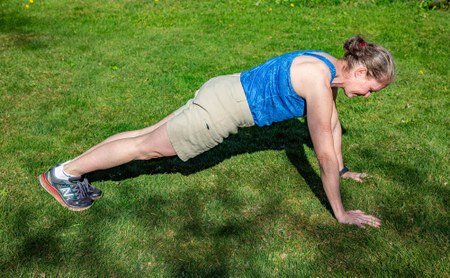
March 2020 stunned us nationwide with national, state, and city park closures, school cancellations, Stay Home orders, and changes to our everyday freedoms. But that doesn’t mean our mental and physical wellness must shut down with it. To develop resilience and versatility in the comfort of your own home, include the plank. It is one of the most versatile upper body movements you can perform to develop core, triceps, shoulders, and chest strength. You can make it part of an anaerobic workout by adding a jump, or a meditative workout by adding a downward-facing dog. Pull out a mat and move!
Base plank
Find a clutter-free space (even outside is perfect to get fresh air and sunshine). Place your hands shoulder width apart on a solid surface in front of you. Be sure both hands are equally loaded if you’re on grass, dirt, or sand. Straighten one leg then the other, so you’re on hands and toes, keeping heels together and body straight. Eyes should look straight down to maintain spinal alignment. Think of pulling your hands and toes together in order to keep the entire front of the body tight. Contract the glutes. Take long, deep breaths, in through the nose and out through the mouth. Hold for at least thirty seconds, performing two or three sets. When you can hold longer, try a variation below.
Base push-up
Keeping your body in a straight line from knees to shoulders, inhale as you slowly lower your nose and chest to the floor, exhale as you press back to starting position. If knee pushups feel easy, straighten your legs so you are on hands and toes, abs held tight to protect the lower back, and lower to the floor until your nose touches. For advanced exercisers, propel yourself off the floor and add a clap (clap pushups) before your hands return to the floor. Perform two or three sets of eight to ten repetitions.
Plank pushups
Once you have mastered the basic plank and pushup, combine them. Start in plank, lower in a pushup, then hold the plank for ten seconds and repeat until you fatigue. Rest a minute and repeat twice more.
Add a leg raise
A harder version of the plank or pushup includes holding one leg up in the air behind you, so that you are on two hands and one foot. Not only does this force the core and arms to work harder, but you also activate the glutes and hamstrings of the leg in the air and add work to the quad of the bracing leg. Perform two sets of eight for each leg with a minute of rest between sets.
Elevate toes
By placing your feet up on a chair, step, or unstable surface such as an exercise ball, you increase the intensity for your upper body and core for both planks and pushups.
Make it anaerobic
To turn this movement into an interval workout, add jumps. After you complete your pushup, jump both knees forward towards your chest and stand or jump upright, reaching hands to the sky. Some refer to this as a burpee or jump squat. Continue for twenty seconds, stop and breathe for ten seconds, then continue seven more rounds. This four-minute protocol is called a Tabata and is one of the toughest home workouts you can do without any equipment.
Make it meditative
At the end of any workout, restore your breathing and focus on what you’re grateful for. Shift your hips into the air from plank position until your heels are as close to the floor as you can get them, shoulders extended, arms near ears. Take long, deep breaths in and out through the nose. When you’re ready, shift back into plank again, hold for five seconds, then press back into down dog. Once your breathing has returned to normal, lower knees to the floor and rest in child’s pose, arms by your sides, palms face up, head turned to one side. Give yourself a pat on the back for doing something positive for your physical and emotional well-being.
Courtenay Schurman is an NSCA-CSCS certified personal trainer, Precision Nutrition Level 2 Certified Nutrition Supercoach, and co-owner of Body Results. She specializes in training outdoor athletes. For more how-to exercises or health and wellness tips, visit her website at bodyresults.com or send a question to court@bodyresults.com.
This article originally appeared in our Summer 2020 issue of Mountaineer Magazine. To view the original article in magazine form and read more stories from our publication, visit our magazine archive.
 Courtenay Schurman
Courtenay Schurman